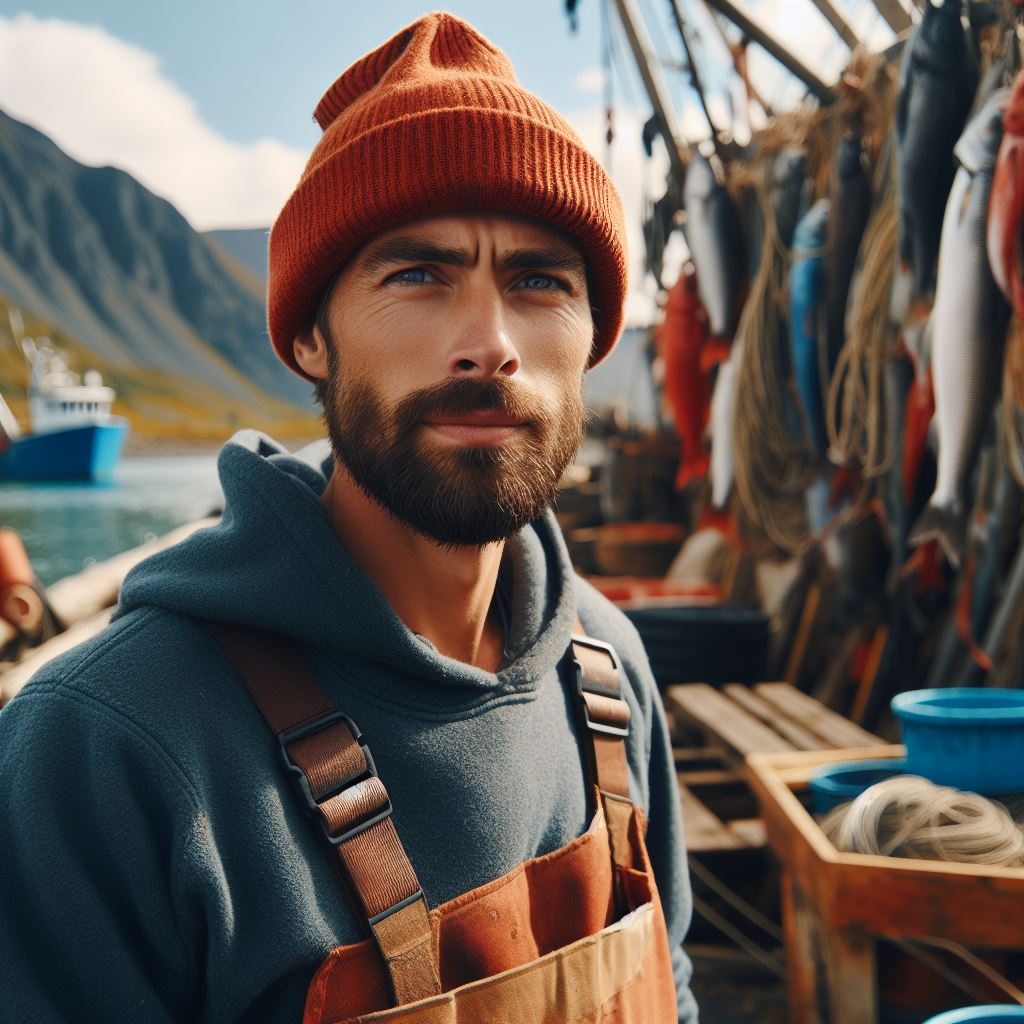Introduction
Definition of sustainable practices in fishing
Sustainable practices in fishing refer to methods that ensure the long-term health and viability of fish populations and the marine ecosystem.
These practices prioritize conservation and minimize negative impacts on the environment and fish stocks.
In the Canadian fishing industry, sustainable practices are of utmost importance.
They help maintain the delicate balance between economic growth and environmental protection.
Sustainable fishing ensures that future generations can enjoy the benefits of abundant fish stocks and a thriving marine ecosystem.
Importance of sustainable practices in Canadian fishing industry
Sustainable practices in Canadian fishing industry
- Protecting fish habitats: Sustainable fishing practices in Canada include implementing measures to safeguard critical fish habitats, such as wetlands and spawning grounds.
- Managing fish stocks: Monitoring fish populations, setting catch limits, and implementing fishing quotas are crucial for sustaining fish stocks and preventing overfishing.
- Reducing bycatch: Techniques like using selective gear and modifying fishing practices help minimize the unintentional catch of non-target species.
- Promoting responsible fishing methods: Encouraging the use of gear and techniques that minimize damage to the marine environment, such as using sustainable fishing gear, ensures the long-term viability of the industry.
- Collaborative management: Effective collaboration between government, industry, and conservation groups is essential for developing and implementing sustainable fishing practices in Canada.
- Enforcing regulations: Strict enforcement of fishing regulations and penalties for non-compliance play a vital role in ensuring that sustainable practices are followed and deter illegal fishing activities.
Basically, the sustainable practices adopted in the Canadian fishing industry play a crucial role in protecting fish populations, preserving marine habitats, and maintaining a sustainable industry.
By prioritizing conservation and responsible fishing methods, the industry can reap the long-term benefits of a healthy marine ecosystem and sustained economic growth.
Overview of Canadian fishing industry
The Canadian fishing industry, rooted in centuries of history, showcases a robust evolution:
- Indigenous peoples pioneered sustainable fishing practices, shaping Canada’s marine heritage.
- In the 15th century, Europeans exploited marine resources, leaving a lasting impact on coastal communities.
- Fishing emerged as a vital economic force, now a major powerhouse driving employment and revenue.
- Commercial fishing, a linchpin, involves key players such as fishermen, processors, and governmental bodies.
- Regionally, Atlantic Canada spotlights lobster and cod, the Pacific commands global markets with salmon, and the Arctic champions sustainability.
- The Canadian government, via Fisheries and Oceans Canada (DFO), enforces regulations and safeguards fish populations.
- DFO conducts scientific research and stock assessments to guide sustainable fisheries practices.
- Eco-certification schemes, like the Marine Stewardship Council (MSC), advocate responsible fishing practices.
- Encouragement for selective fishing gear minimizes bycatch, safeguarding non-target species.
- Fisheries management plans set sustainable catch limits, protecting crucial breeding grounds.
- Challenges include overfishing, habitat destruction, and climate change threatening Canadian fisheries.
- Proactive measures involve collaborative efforts uniting stakeholders, scientists, and Indigenous communities for sustainable fishing.
- Consumers contribute by choosing certified seafood, supporting local fisheries, and promoting sustainability.
Lastly, the Canadian fishing industry, deeply rooted in history, is an economic driver transitioning toward a resilient and responsible future.
Sustainable practices, collaborative initiatives, and consumer support are pivotal, requiring ongoing research, innovation, and cooperation for enduring viability.
Read: Forestry Equipment: Tools of the Trade
Challenges in achieving sustainable practices in Canadian fishing
Despite efforts to implement sustainable practices, the Canadian fishing industry faces several challenges that hinder its progress towards long-term sustainability.
Overfishing and depletion of fish stocks
Overfishing remains a significant issue in Canadian waters.
The relentless pursuit of certain fish species has resulted in severe declines in their populations, jeopardizing their sustainability.
The enforcement of fishing quotas and stricter regulations are crucial in preventing further depletion of fish stocks.
However, the temptation to exceed these limits for short-term gains continues to pose a challenge.
Impact on marine ecosystems and biodiversity
Unsustainable fishing practices often disrupt marine ecosystems, leading to a loss of biodiversity.
Targeting specific fish species disrupts the delicate balance in the food chain and can have cascading effects on other organisms.
The decline of certain fish populations can also result in an increase in their prey species, further destabilizing marine ecosystems.
A holistic approach that considers the interconnectedness of marine species is necessary to mitigate the impact on biodiversity.
Bycatch and discards.
Bycatch, the accidental capture of non-targeted species, is a common problem in fishing operations.
This unintentional catch includes juvenile fish, endangered species, and other marine organisms.
The discarded bycatch often leads to unnecessary wastage and significant ecological consequences.
Implementing selective fishing methods and using gear modifications can help reduce bycatch and minimize its impact on non-targeted species.
Unlock Your Career Potential
Visualize a clear path to success with our tailored Career Consulting service. Personalized insights in just 1-3 days.
Get StartedClimate change and its effects on fish populations
The warming of oceans due to climate change is altering the distribution and behavior of fish populations.
Changing water temperatures impact the availability of food and affect fish reproductive patterns.
As fish populations respond to these changes, fishing practices must adapt accordingly.
Effective management strategies should consider the impacts of climate change on fish populations to ensure their long-term sustainability.
In general, the achievement of sustainable practices in Canadian fishing faces significant challenges.
Overfishing, the impact on marine ecosystems and biodiversity, bycatch and discards, and climate change pose threats that require immediate attention.
To address these challenges, a multi-faceted approach involving stricter regulations, improved fishing techniques, and increased awareness of environmental impacts is necessary.
By working together, stakeholders can create a sustainable future for Canadian fisheries and preserve the health of our oceans.
Read: Canadian Forest Types and Their Care
Sustainable fishing methods and initiatives in Canada
Fisheries management systems and regulations
Fisheries management systems and regulations play a crucial role in ensuring sustainable practices in Canadian fishing.
Canada has implemented various management systems to monitor and regulate fishing activities, such as catch limits and fishing gear restrictions.
These regulations aim to prevent overfishing and protect vulnerable species by promoting responsible fishing practices.
Conservation measures and quotas
Conservation measures and quotas are essential tools in sustainable fishing practices in Canada.
Quotas are set to control the amount of fish that can be harvested, preventing overfishing and allowing populations to recover.
These measures take into account scientific data and assessments to ensure the long-term viability of fish stocks.
Marine protected areas and sustainable fishery closures
Marine protected areas (MPAs) and sustainable fishery closures are crucial components of sustainable fishing in Canada.
MPAs are designated areas where fishing activities are restricted or prohibited, allowing marine ecosystems to regenerate and wildlife to thrive.
Sustainable fishery closures are temporary measures put in place to protect spawning grounds or sensitive habitats, ensuring the reproductive success of fish populations.
Adoption of eco-certification programs
Canada has embraced the adoption of eco-certification programs to promote sustainable fishing practices.
Eco-certification programs, such as the Marine Stewardship Council (MSC) certification, ensure that fisheries meet strict sustainability standards.
These certifications provide consumers with confidence that the fish they are purchasing have been sourced ethically and sustainably.
Collaborative efforts with Indigenous communities
Collaborative efforts with Indigenous communities are essential for sustainable fishing practices in Canada.
Indigenous communities have a deep understanding of the local ecosystems and traditional fishing practices that have sustained them for generations.
By engaging and partnering with Indigenous communities, Canada can benefit from their knowledge and incorporate their sustainable fishing practices.
All in all, sustainable fishing methods and initiatives in Canada are crucial for the long-term health of marine ecosystems.
Fisheries management systems and regulations, conservation measures and quotas, MPAs, eco-certification programs, and collaboration with Indigenous communities are all essential components in ensuring sustainable practices in Canadian fishing.
By implementing and improving these measures, Canada can continue to protect its valuable fish stocks and support the livelihoods of fishing communities while preserving the health of its oceans for future generations.
Read: Forestry and Indigenous Land Stewardship

Benefits of Sustainable Fishing Practices
Preservation and Recovery of Fish Stocks
Sustainable fishing practices ensure that fish stocks are protected and have the opportunity to recover and replenish.
By setting catch limits, implementing size restrictions, and enforcing fishing seasons, overfishing can be prevented.
This allows fish populations to stabilize, ensuring a consistent supply of fish for future generations and maintaining biodiversity.
Protection of Marine Habitats and Ecosystems
Sustainable fishing practices prioritize the protection of marine habitats and the preservation of delicate ecosystems.
By avoiding destructive fishing methods such as bottom trawling, coral reefs and seabed habitats can be safeguarded.
This helps to maintain the balance of marine ecosystems, protecting the species that rely on them for survival.
Economic Benefits for Fishing Communities
Sustainable fishing practices can bring economic benefits to fishing communities, both in the short and long term.
By managing fish stocks responsibly, communities can ensure a steady income from fishing activities.
Furthermore, sustainable practices promote the development of local businesses, such as seafood restaurants and eco-tourism ventures.
This creates employment opportunities and boosts the local economy, contributing to the overall well-being of fishing communities.
Enhanced Reputation and Market Demand for Sustainable Seafood
Adopting sustainable fishing practices can enhance the reputation of Canadian fishing industry on a global scale.
Consumers are becoming increasingly aware of the importance of sustainability and are demanding sustainable seafood options.
By meeting these demands, Canadian fishing industry can attract more customers and gain a competitive edge in the market.
This leads to increased profitability and a positive image for Canadian seafood products.
In a nutshell, adopting sustainable fishing practices in Canada brings numerous benefits to both the environment and fishing communities.
Preservation and recovery of fish stocks, protection of marine habitats, economic advantages, and enhanced market demand are key advantages.
By implementing and supporting sustainable practices, Canada can ensure the longevity of its fishing industry and preserve its oceans for future generations.
Read: Economic Impact of Forestry in Canada
Success stories and case studies
Examples of Canadian fishing companies implementing sustainable practices
- Clearwater Seafoods: This Nova Scotia-based company has implemented extensive measures to ensure sustainable fishing practices.
- Atlantic Trawlers Association: This association of fishing companies in Atlantic Canada has made significant efforts to reduce bycatch and protect sensitive habitats.
- SeaChoice: A partnership between four major Canadian conservation organizations, SeaChoice works with seafood suppliers to promote sustainable practices.
Positive environmental outcomes and community engagement
- Increased fish populations: Canadian fishing companies that have adopted sustainable practices have observed an increase in fish populations and healthy ecosystems.
- Improved habitat protection: By implementing sustainable practices, companies have actively contributed to the protection and restoration of critical marine habitats.
- Reduced bycatch: Through the use of selective fishing gear and techniques, fishing companies have successfully decreased unintentional catch of non-target species.
- Positive economic impact: These sustainable practices have not only benefited the environment but also generated economic opportunities for local communities.
- Community partnerships: Canadian fishing companies have actively engaged with local communities to tackle environmental challenges together, resulting in cohesive and sustainable fishing practices.
- Indigenous involvement: Sustainable fishing practices have provided opportunities for Indigenous communities to actively participate in resource management and conservation.
- Certification programs: Initiatives like the Marine Stewardship Council (MSC) certification have encouraged companies to adopt sustainable practices and gain recognition for their efforts.
- Consumer demand: Increasing consumer awareness and demand for sustainably caught seafood have incentivized fishing companies to adopt responsible practices.
Essentially, the success stories and case studies discussed above demonstrate the significant strides made by Canadian fishing companies in implementing sustainable practices.
Through collaboration with conservation organizations, engagement with local communities, and the adoption of selective fishing gear, these companies have achieved positive environmental outcomes while ensuring economic viability.
These examples serve as inspiration for other fishing companies to follow suit and contribute to the long-term sustainability of Canadian fisheries.
With continued efforts and industry-wide commitment, Canada can establish itself as a global leader in sustainable fishing.
Challenges and Future Prospects
Potential Barriers to Widespread Adoption of Sustainable Fishing Practices
- Lack of awareness about the benefits of sustainable fishing among fishermen and consumers.
- Resistance to change traditional fishing methods and a fear of economic losses.
- Limited access to resources, such as funds and training, needed to implement sustainable practices.
- Inadequate monitoring and enforcement of sustainable fishing regulations, leading to non-compliance.
Government Policies and Industry Collaboration
- Government policies that prioritize sustainable fishing practices can incentivize industry players to adopt them.
- Collaboration between government bodies, fishing communities, and industry stakeholders is crucial for effective implementation.
- Sharing knowledge and expertise between different sectors can lead to innovative solutions and best practices.
Innovations in Technology and Fishing Gear to Reduce Environmental Impact
- The development of selective fishing gears, such as escape panels and modified nets, can reduce bycatch and habitat damage.
- Integration of real-time monitoring systems and GPS technology in fishing vessels can improve traceability and control illegal activities.
- Alternative energy sources, like solar-powered vessels, can minimize carbon emissions and dependence on fossil fuels.
International Cooperation for Sustainable International Fishing Practices
- Cooperation among countries is crucial to address issues related to overfishing and the conservation of shared fish stocks.
- Harmonizing fishing regulations and implementing effective monitoring systems can prevent illegal, unreported, and unregulated fishing.
- Sharing scientific research and data can improve understanding of fish populations and enable evidence-based decision-making.
In fact, while there are challenges to the widespread adoption of sustainable fishing practices, including lack of awareness and limited resources, there are potential solutions.
Government policies, industry collaboration, technological innovations, and international cooperation all play important roles in promoting sustainable practices.
By addressing these challenges and embracing future prospects, Canada can ensure the long-term viability of its fishing industry while conserving marine ecosystems for future generations.
Conclusion
Recap of the importance of sustainable practices in Canadian fishing
Throughout this blog section, we have discussed the significance of sustainable practices in Canadian fishing.
It is crucial for the long-term health of our oceans, the preservation of marine species, and the sustenance of our fishing industry.
Call to action for individuals, fishing companies, and policymakers to prioritize sustainability in the industry
To ensure the future viability of Canadian fishing, we must take action.
Individuals can support sustainable fishing by choosing to consume responsibly sourced seafood and spreading awareness about the importance of sustainable practices.
Fishing companies should invest in innovative technologies and methods that minimize bycatch, reduce fuel consumption, and promote responsible fishing practices.
By doing so, they can maintain profitable operations while safeguarding the marine environment.
Policymakers play a crucial role in supporting and implementing sustainable fishing practices.
They should establish regulations and incentives that encourage responsible fishing, such as catch limits, gear restrictions, and funding for research and development of sustainable fishing methods.
Additionally, they should collaborate with industry stakeholders and indigenous communities to create comprehensive fisheries management plans.
By collectively prioritizing sustainability in the Canadian fishing industry, we can ensure the health and productivity of our oceans for future generations.
Let us act now to preserve and protect this valuable natural resource.




